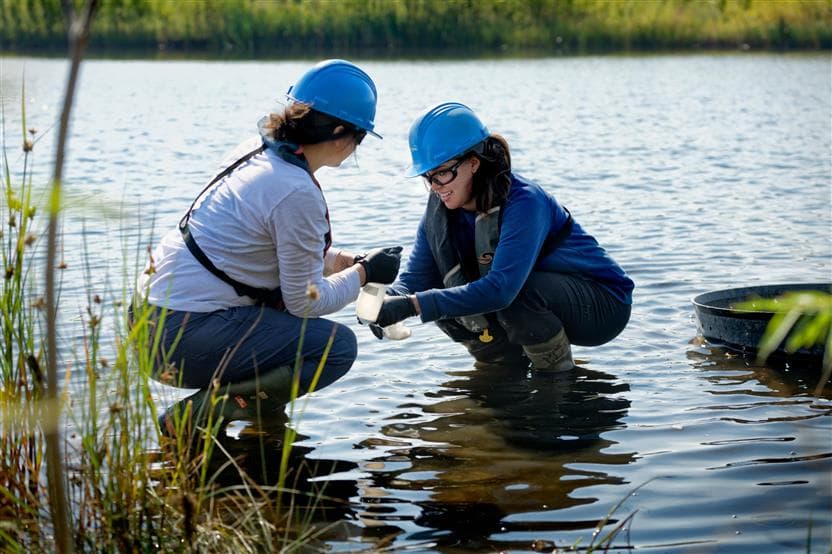Water is a precious natural resource and an essential part of our operations. We use it for all stages of oil production, from oil sands extraction and bitumen upgrading to refining products and general site use. Not only do we want to manage our water use, we want to reduce our impacts on the watersheds where we operate and protect the environment.
We’re improving our water performance and management across all our operations. Our approach needs to consider all components of water management including reducing, recycling, reusing and releasing treated mine water.
Community engagement and industry collaboration
The Athabasca watershed has a deep cultural significance for the region’s Indigenous Peoples. We acknowledge its spiritual importance to community members and the understanding that the health of the rivers, landscape, wildlife and people are all interconnected. We strive for meaningful engagement that respects the unique and constitutional rights of Indigenous Peoples, including treaty rights and the deep connection with land and water. By continuing to learn about the rights, history, customs, beliefs, traditions and aspirations of Indigenous Peoples, we can apply this knowledge to our water management practices.
Working together with Indigenous communities, we will strive to identify solutions to achieve progressive reclamation and our mine closure outcomes and commitments. We engage with local communities during the development of our water management plans and as projects progress. We continue to explore and implement local initiatives that will result in more efficient water use, with less freshwater drawn from local water sources. We’re also a member of a watershed planning and advisory council that evaluates changes to the Athabasca watershed over time and advises on potential policy and management actions.
Monitoring
Monitoring is critical for measuring the effectiveness of our water management processes. We are required to monitor water quality on our sites and assess ecosystem impacts in the watersheds where we operate. We also participate in the Oil Sands Monitoring (OSM) program along with Indigenous communities and government stakeholders to conduct regional monitoring. The OSM program is specifically focused on tracking potential environmental impacts from oil sands facilities. It also assesses potential cumulative environmental effects from oil sands development to help inform future monitoring, mitigation and management decisions.
Regulatory requirements
While we regularly submit updates of our reclamation and closure plans to the Alberta Energy Regulator, we are waiting for the federal and provincial governments to finalize the criteria for safely releasing treated water. Returning treated water is a global best practice used by municipal, commercial, industrial and agricultural sectors. Governments regulate water releases to protect the receiving waterbodies and downstream users. Other types of Canadian mines – including copper, nickel, iron ore, diamond and gold operations – have regulations to treat and release water used in their processes. The federal government is committed to developing these regulations for the oil sands by 2025. Having these regulations in place will allow us to restore and reconnect ecosystems in areas where we’ve operated. Our systems, combined with strict regulations, will ensure water can be safely released and protect the environment (fish, insects, birds, plants, animals) and downstream users. Once the criteria for releasing treated water are established, we can design treatment plans to meet these objectives.
Our approach
Water at oil sands mines contains components such as sand, silt, clay, organics, salts, and a range of metals. These constituents are largely common to process water used in other types of mining and many other industrial activities. There is a wide range of proven technologies already in use in Canada and globally to treat process water so that it is safe for release.
We have made significant investments in applying, adapting and testing different water management approaches and the effectiveness of various treatment processes and technologies on oil sands mine water to achieve levels safe for release to the environment. Every site is different and requires flexibility when choosing appropriate technologies for treatment. Our solutions for water management will continue to include reuse and recycling and where water release is appropriate, it will be protective of the environment and be considered with the input and knowledge of Indigenous communities.


.jpeg?mw=304&modified=20230215224342&hash=9529236DC12D44847705F4718977C77A)

.jpg?mw=304&modified=20220921171014&hash=8FD467694C312EAD1B1CBB6AE8AE9DCB)
